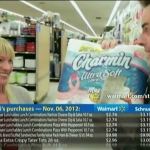Remember those Walmart commercials featuring real shoppers who bought groceries at their favorite store, then headed to Walmart, where a cheery host would surprise them with a line-by-line receipt comparison showing them how much less everything cost at Walmart?
They’re back! Sort of. Just be sure to read the tiny disclaimers.
Walmart has begun airing a new series of regional TV commercials, comparing the prices of a cart full of groceries at Walmart and a local competitor. The ads are very similar to the controversial “Market Basket Challenge” commercials that first aired back in 2012, and they feature many of the same elements – a cheery host, a line-by-line receipt comparison, a big reveal showing how much less the total price was at Walmart, and a shopper surprised at how much they could have saved by doing their grocery shopping at Walmart instead of at their local grocery store.
The only things missing from the ads this time, are “real” shoppers and “real” purchases.
The “Obvious Choice Challenge” features a cart full of groceries from Walmart, alongside a cart full of the same items said to have been purchased at a local competitor – Kroger, in the case of the example above (click to play). As in the Market Basket Challenge ads, the Obvious Choice Challenge ads include a scrolling list of items and prices at the bottom of the screen, ending with a final total that shows Walmart winning the challenge. But the commercials differ slightly from the format of the originals, which followed shoppers around the store as they filled their carts.
That’s because there aren’t any shoppers filling their carts in these ads. Instead, Walmart did the shopping. And the shoppers are actors.
The first sign that these commercials aren’t as “real” as the Market Basket Challenge commercials purported to be, is the small disclaimer at the beginning: “Actor portrayal.” Next, the host tells the shopper/actor that “we shopped the same grocery list at two different stores” – “we,” presumably being Walmart itself.
The Market Basket Challenge commercials featured actual, non-actor shoppers who were instructed to buy whatever items they would normally purchase at their favorite grocery store, then buy the same items at Walmart for the cameras. Items and prices would scroll along the bottom of the screen, ending with the on-camera host revealing just how much less the total price was at Walmart. A handful of items might actually cost somewhat more at Walmart, but the overall message was that you could buy a cart full of groceries for less at Walmart than you could at a traditional grocery store.
Everything seemed on the up-and-up, but there were some criticisms. The commercials didn’t take coupons into account, at a time when many grocery stores featured perks like double coupons and digital coupons that Walmart didn’t. Walmart won the challenge every time, at least in the price comparisons that were made into commercials – Walmart wouldn’t say whether any shopping trips didn’t favor Walmart and never made it to air.
But the most serious criticisms came in the form of formal complaints filed by a Walmart competitor. St. Louis-based Schnucks filed complaints with two states’ Attorneys General, complaining that the ads were inaccurate, unfair and unlawful. Firstly, Schnucks argued that the specific items compared did not represent a typical, representative sample of groceries and prices, since random-weight items like meat and produce were excluded from Walmart’s comparisons. And “any percentage price comparison over a limited number of selected items is inherently deceptive and misleading” because “they create the false impression that the price disparities shown are typical and resulted from a random selection of products and consumers,” Schnucks asserted.
Schnucks cited a 2004 decision by the National Advertising Division (NAD), a unit of the Advertising Self-Regulatory Council, which aimed to resolve a similar dispute at the time. That decision found that comparing prices of a limited selection of grocery items was misleading, because a “reasonable consumer takeaway is that the advertiser’s prices are substantially lower than its competitors’ on a store-wide basis.”
The new Obvious Choice Challenge commercials address that concern, with a disclaimer that the “price comparison applies to the featured items and does not apply store-wide.” The commercials also prominently feature meat and produce items, the prices of which are “based on price-per-pound for (the) same quantity.”
But who decided which grocery items would be compared? The 2004 NAD decision also raised concerns about how items featured in a price comparison were selected. The grocer who filed the original complaint argued that a competitor running a similar price-comparison promotion “hand-selected the items” itself, in a way that would ensure the total price would “wind up considerably lower than the competitors’.” And if it didn’t, “the process is simply repeated.” As a result, the complaint sarcastically suggested, the only proper disclosure would read, “We hand-pick the items which we believe will give us the lowest market basket price, and if we’re wrong, we’ll choose again until we get it right.”
The NAD noted that “federal guidelines do not require independent third parties to conduct the market basket promotion or that the items be randomly selected, nor do they prohibit ‘re-shopping’.” But compliance with those guidelines “in and of itself, does not ensure that a misleading message will not be conveyed by the advertising,” the NAD warned.
Going by that definition, then, Walmart’s Obvious Choice Challenge could be categorized as “misleading”. Unlike its previous incarnation, the new version of the ad campaign doesn’t feature a selection of products that a shopper chose, but a selection of products that Walmart chose. And, surprise, with only one exception out of dozens of products compared in two commercials that are available to view online, Walmart wins the side-by-side price comparison of each and every item. It’s entirely possible Walmart would still win a price comparison using randomly-selected grocery products chosen by actual shoppers, instead of hand-picked items and actors portraying actual shoppers. But we’ll never know.
So shopper beware. You may well still save money by doing more of your grocery shopping at Walmart. But in the case of the Obvious Choice Challenge – don’t always believe everything you see on TV.













